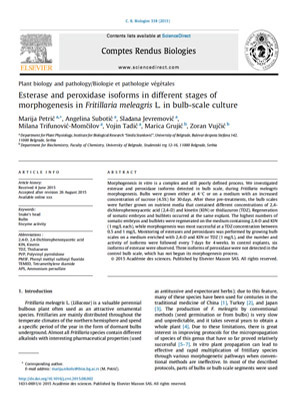NEWS 2015
Esterase and peroxidase isoforms in different stages of morphogenesis in Fritillaria meleagris L. in bulb-scale culture
Marija PETRIĆ¹, Angelina SUBOTIĆ¹, Slađana JEVREMOVIĆ¹, Milana TRIFUNOVIĆ-MOMČILOV¹, Vojin TADIĆ¹, Marica GRUJIĆB¹, Zoran VUJČIĆ²
Comptes Rendus Biologies (2015)
doi:10.1016/j.crvi.2015.08.002
¹Department for Plant Physiology, Institute for Biological Research Siniša Stanković, University of Belgrade, Belgrade, Serbia
²Department for Biochemistry, Faculty of Chemistry, University of Belgrade, Studentski trg 12-16, 11000 Belgrade, Serbia
Abstract
Morphogenesis in vitro is a complex and still poorly defined process. We investigated esterase and peroxidase isoforms detected in bulb scale, during Fritillaria meleagris morphogenesis. Bulbs were grown either at 4 °C or on a medium with an increased concentration of sucrose (4.5%) for 30 days. After these pre-treatments, the bulb scales were further grown on nutrient media that contained different concentrations of 2,4-dichlorophenoxyacetic acid (2,4-D) and kinetin (KIN) or thidiazuron (TDZ). Regeneration of somatic embryos and bulblets occurred at the same explant. The highest numbers of somatic embryos and bulblets were regenerated on the medium containing 2,4-D and KIN (1 mg/L each), while morphogenesis was most successful at a TDZ concentration between 0.5 and 1 mg/L. Monitoring of esterases and peroxidases was performed by growing bulb scales on a medium enriched with 2,4-D and KIN or TDZ (1 mg/L), and the number and activity of isoforms were followed every 7 days for 4 weeks. In control explants, six isoforms of esterase were observed. Three isoforms of peroxidase were not detected in the control bulb scale, which has not begun its morphogenesis process.

